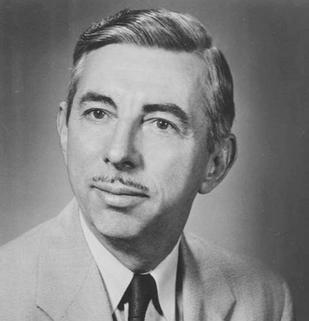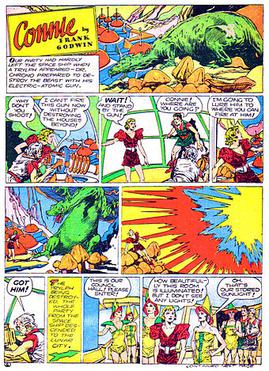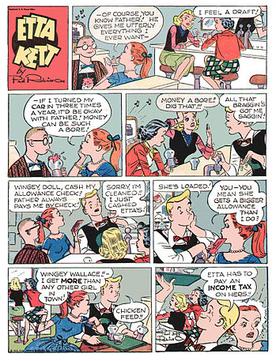
Mutt and Jeff is a long-running and widely popular American newspaper comic strip created by cartoonist Bud Fisher in 1907 about "two mismatched tinhorns". It is commonly regarded as the first daily comic strip. The concept of a newspaper strip featuring recurring characters in multiple panels on a six-day-a-week schedule had previously been pioneered through the short-lived A. Piker Clerk by Clare Briggs, but it was Mutt and Jeff as the first successful daily comic strip that staked out the direction of the future trend.
Notable events of 1962 in comics. Starting January, most companies raise their comics from 10 to 12 cents.
United Feature Syndicate, Inc. (UFS) is a large American editorial column and comic strip newspaper syndication service based in the United States and established in 1919. Originally part of E. W. Scripps Company, it was part of United Media from 1978 to 2011, and is now a division of Andrews McMeel Syndication. United Features has syndicated many notable comic strips, including Peanuts, Garfield, Li'l Abner, Dilbert, Nancy, and Marmaduke.

Rip Kirby is an American comic strip created by Alex Raymond and Ward Greene featuring the adventures of private detective Rip Kirby. The strip ran from 1946 to 1999 and was in the hands of artist John Prentice for more than 40 years.

Al Smith was an American cartoonist whose work included a long run on the comic strip Mutt and Jeff. Comics historian R. C. Harvey postulates that Smith's nearly 50-year run on the strip was, at the time of Smith's retirement, a world record for longevity. Smith also ran a comic strip syndication service — mainly serving weekly newspapers — from the 1950s until the late 1990s.
HaroldSeeger was an American animated cartoon producer and director who owned his own studio, the Hal Seeger Studio. He is most famous as the creator of the 1960s animated series Batfink, Milton the Monster and Fearless Fly. During the 1930s and 1940s he was also active as a comics writer and artist, most famously for the Betty Boop comic strip and Leave It to Binky.

Tribune Content Agency (TCA) is a syndication company owned by Tribune Publishing. TCA had previously been known as the Chicago Tribune Syndicate, the Chicago Tribune New York News Syndicate (CTNYNS), Tribune Company Syndicate, and Tribune Media Services. TCA is headquartered in Chicago, and had offices in various American cities, the United Kingdom, the Netherlands, and Hong Kong.
Notable events of 1946 in comics.
This is a timeline of significant events in comics in the 1920s.
This is a timeline of significant events in comics in the 1910s.
This is a timeline of significant events in comics in the 1900s.

Torchy is a comic strip and, primarily, a series of comic books featuring the ingenue Torchy Todd, created by the American "good girl art" cartoonist Bill Ward during 1944. The character was ranked 97th of the 2011 Comics Buyer's Guide's "100 Sexiest Women in Comics" list.

Agatha Crumm is a newspaper comic strip created by the cartoonist Bill Hoest and distributed by King Features Syndicate. The strip ran from October 24, 1977, until 1997. Agatha Crumm was Hoest's third strip, following Bumper Snickers (1974).

Connie is an American adventure comic strip created by the cartoonist Frank Godwin, who introduced a book illustration style to the comics page. The strip ran from 1927 to 1941 for the Ledger Syndicate. Connie debuted as a Sunday page on November 13, 1927. The strip was syndicated in France as Cora in the weekly paper Le Journal de Mickey.

Etta Kett is a long-running comic strip created by Paul Robinson, which ran from December 7, 1925 to November 9, 1974.

Teena is a comic strip about a teenage girl, created by Hilda Terry. It ran from July 1, 1944, to 1963, distributed by King Features Syndicate.

Hal Rasmusson was an American cartoonist best known for the comic strip Aggie Mack, about a teenage girl.
The New York Herald Tribune Syndicate was the syndication service of the New York Herald Tribune. Syndicating comic strips and newspaper columns, it operated from c. 1914 to 1966. The syndicate's most notable strips were Mr. and Mrs., Our Bill, Penny, Miss Peach, and B.C. Syndicated columns included Walter Lippmann's Today and Tomorrow, Weare Holbrook's Soundings, George Fielding Eliot's military affairs column, and John Crosby's radio and television column. Irita Bradford Van Doren was book review editor for a time.
The New York World was one of the first newspapers to publish comic strips, starting around 1890, and contributed greatly to the development of the American comic strip. Notable strips that originated with the World included Richard F. Outcault's Hogan's Alley, Rudolph Dirks' The Captain and the Kids, Denys Wortman's Everyday Movies, Fritzi Ritz, Gus Mager's Hawkshaw the Detective, Victor Forsythe's Joe Jinks, and Robert Moore Brinkerhoff's Little Mary Mixup.
Charlie Chaplin comics have been published in the United States, the United Kingdom, and Europe. Charlie Chaplin comic strips first appeared in 1915 in the U.S. and the U.K., cashing in on the tremendous popularity of the comedian at the time; they were some of the earliest comics inspired by the popularity of a celebrity. Although Charlie Chaplin comic strips didn't enjoy enduring popularity in the U.S., a Chaplin comic strip was published in the U.K. from 1915 until the late 1940s, while in France there were Chaplin comics published for more than 50 years.










